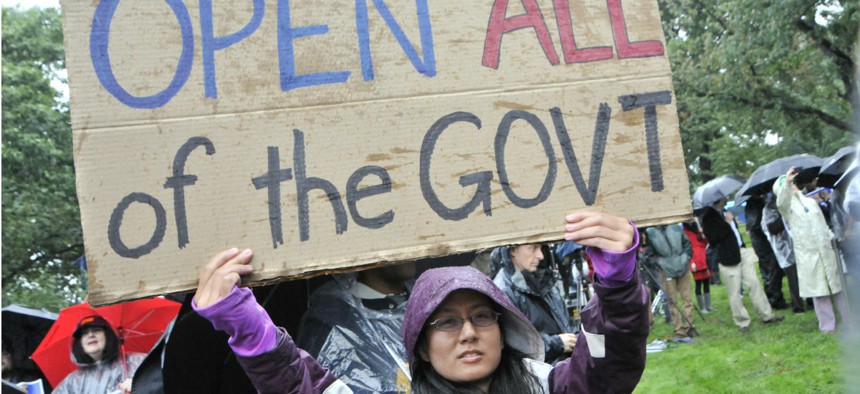
Federal workers protest the government shutdown in October 2013. AFGE file photo
UPDATED: See Who Gets Sent Home in a Shutdown
Some agencies would furlough virtually everyone, while others would remain completely open if there is a lapse in appropriations.
This story has been updated to reflect new Defense Department shutdown guidance.
The government is just hours away from seeing its funding expire, and Congress has yet to forge any clear path for how it will avoid a shutdown.
For about 860,000 federal employees, that means they are facing unpaid furloughs come first thing Saturday—or, more realistically for most of them, come Monday morning. The remaining roughly 60 percent of feds would continue to report to work, but would not be guaranteed pay until after the government reopens. Historically, Congress has elected to also grant back pay to federal workers who were sent home during lapses in appropriations.
An update to Office of Management and Budget guidance during the Obama administration required agencies to refresh their shutdown plans at least every two years starting in 2015. Nearly all agencies updated their documents spelling out who would or would not be furloughed in September of that year. Sixty-three agencies submitted their updated shutdown guidance to OMB in the last two months detailing who they would furlough under an appropriations lapse.
The plans vary significantly from agency to agency. The Veterans Affairs Department, for example, would furlough just 4.2 percent of 377,000 employees, while the Housing and Urban Development Department would furlough more than 96 percent of its 7,800-person workforce. The National Labor Relations Board would require just 10 of its 1,600 employees to work through a shutdown.
Some agencies would experience a shutdown in vastly different ways among their components. At the Commerce Department, the Census Bureau would furlough 99.9 percent of its workers, while the National Oceanic and Atmospheric Administration would have more than half of its employees working. About 87 percent of the Internal Revenue Service would face furloughs, compared to less than 20 percent of the Treasury Department’s Bureau of the Fiscal Service.
At the Health and Human Services Department, the Indian Health Service would retain 95 percent of its workers while the National Institutes of Health would have less than one-quarter of its employees reporting. Agency overseers would also have varying roles. The Interior Department would furlough its entire inspector general’s office, while Treasury would retain 15 percent of its watchdog employees.
The numbers in the chart below are fluid, and can vary based on a shutdown’s duration and various factors that might force agencies to recall workers. The Defense Department in 2013 initially furloughed about 400,000 civilian employees, but later recalled nearly all of them after Pentagon and Justice Department officials determined that a measure to ensure military personnel continued to receive their paychecks on time provided the authority for practically the entire civilian workforce to report for duty.
The Pentagon did not respond to an inquiry into what approach it was planning to take this year, but early on Friday, the Defense Department posted 14-page “guidance for continuation operations.” If a shutdown happens, here are the basics, according to the guidance: Active duty servicemembers, keep going to work. Defense civilians: don’t, unless you’ve been designated excepted or exempted. Everyone at Defense: cancel your Temporary Duty travel. Contractors: keep working, as long as your program is fully funded.
The State Department sent home less than 1 percent of its workforce in 2013, but warned it would have had to furlough thousands more employees if the appropriations lapse had continued much longer. The Federal Emergency Management Agency announced it brought back about 200 employees in the middle of the 2013 shutdown as a new tropical storm developed.
Government Executive used the updated plans, as well as those submitted in 2015 or executed during the shutdown in 2013, to provide a full picture of what percentage of their workforces agencies are planning to furlough. Here are the furlough rates for most large agencies:

NEXT STORY: Tax Planning in a Time of Change







